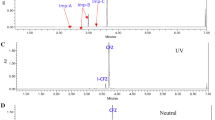Abstract
Erdafitinib is a potent and selective tyrosine kinase receptor inhibitor used to treat advanced or metastatic urothelial carcinoma. The purpose of this study is to explore the degradation behavior of erdafitinib when exposed to various stress conditions as per ICH, along with its compatibility with various excipients under accelerated stability conditions. The degradation and interaction products formed under various conditions were separated using phenomenix Gemini C18 column (250 × 4.6 mm; 5 μm) with 10 mM ammonium acetate (pH 4.50) buffer and methanol as mobile phase in gradient elution mode at a flow rate of 1 mL/min. Erdafitinib was found to be labile in hydrolytic, photolytic and oxidative stress conditions. It was also found to be incompatible with polyethylene glycol-4000, polyvinyl pyrrolidone-K30, crospovidone and carboxymethylcellulose when exposed to accelerated stability conditions. A total of eight novel degradation products and one interaction product were generated. LC-Q TOF-MS/MS studies were conducted to propose the structures of degradation and interaction products formed by comparing with the fragmentation pattern of the drug. NMR study was also conducted to confirm the chemical structures of two degradation products (DP7 and DP8). Subsequently, the degradation pathway of erdafitinib was also laid down. Further, in silico toxicity and mutagenicity data was generated using DEREK and Sarah software. DP1, DP4, DP5, DP6, DP7 and DP9 show mutagenicity as endpoint.





Similar content being viewed by others
Data availability
The data that support the findings of this study is available in the manuscript as well as supporting information files. In addition, data can be available from the corresponding author upon reasonable request.
References
Bharate SS (2021) Critical analysis of drug product recalls due to nitrosamine impurities. J Med Chem 64(6):2923–2936
Blessy M, Patel RD, Prajapati PN, Agrawal YJ (2014) Development of forced degradation and stability indicating studies of drugs—a review. J Pharm Anal 4(3):159–165
Scheers E, Borgmans C, Keung C, Bohets H, Wynant I, Poggesi I, Cuyckens F, Leclercq L, Mamidi R (2021) Metabolism and disposition in rats, dogs, and humans of erdafitinib, an orally administered potent pan-fibroblast growth factor receptor (FGFR) tyrosine kinase inhibitor. Xenobiotica 51(2):177–193
Elawady T, Khedr A, Nahed EE, Belal F (2022) Study of erdafitinib stress degradation behavior using HPLC-UV analysis and multistage fragmentation ion trap mass spectrometry. Microchem J 179:107432
Singh S, Bakshi M (2000) Guidance on the conduct of stress tests to determine inherent stability of drugs. Asian J Pharm 24–24
ICH (2006) Stability testing of new drug substances and products Q1A(R2). International Council for Harmonisation, IFPMA, Geneva, Switzerland
ICH (2005) Photostability testing of new drug substances and products Q1B. International Council for Harmonisation, IFPMA, Geneva, Switzerland
Rowe RC, Sheskey P, Quinn M (2009) Handbook of pharmaceutical excipients. Libros Digitales-Pharmaceutical Press
Kurmi M, Sahu A, Ladumor MK, Bansal AK, Singh S (2019) Stability behaviour of antiretroviral drugs and their combinations. 9: identification of incompatible excipients. J Pharm Biomed Anal 166:174–182
Dhiman V, Singh DK, Ladumor MK, Singh S (2017) Characterization of stress degradation products of amodiaquine dihydrochloride by liquid chromatography with high-resolution mass spectrometry and prediction of their properties by using ADMET Predictor™. J Sep Sci 40(23):4530–4540
Pravinchandra S, Kurmi M, Kumar S, Singh S (2015) Forced degradation of lafutidine and characterization of its non-volatile and volatile degradation products using LC-MS/TOF, LC-MS n and HS-GC-MS. NJC 39(12):9679–9692
Velip L, Dhiman V, Kushwaha BS, Golla V, Gananadhamu S (2022) Identification and characterization of urapidil stress degradation products by LC-Q-TOF-MS and NMR: toxicity prediction of degradation products. J Pharm Biomed Anal 211:114612
Baertschi S (2005) Pharmaceutical stress testing-predicting drug degradation; special Indian edn. Taylor & Francis Group, New York
Lecoeur M, Vérones V, Vaccher C, Bonte JP, Lebegue N, Goossens JF (2012) Structural elucidation of degradation products of a benzopyridooxathiazepine under stress conditions using electrospray orbitrap mass spectrometry—study of degradation kinetic. Eur J Pharm Sci 45(5):559–569
Liu S, Zhao Z, Wang Y (2019) Construction of N-heterocycles through cyclization of tertiary amines. Chem Eur J 25(10):2423–2441
Sahu A, Sengupta P (2020) Time of flight mass spectrometry based in vitro and in vivo metabolite profiling of ribociclib and their toxicity prediction. J Chromatogr B Biomed Appl 1147:122142
Wang D, Luo L, Peng Y, Wang J, Liang J, Xu D, Feng H, Zeng L, Wang J (2020) Detection of two genotoxic impurities in drug substance and preparation of imatinib mesylate by LC–MS/MS. Chromatographia 83(7):821–828
Shah RP, Sahu A, Singh S (2013) LC-MS/TOF, LC-MSn, on-line H/D exchange and LC-NMR studies on rosuvastatin degradation and in silico determination of toxicity of its degradation products: a comprehensive approach during drug development. J Anal Bioanal Chem 405(10):3215–3231
Acknowledgements
The authors are very thankful to the National Institute of Pharmaceutical Education and Research [NIPER], Hyderabad, for providing the research facilities; Science and Engineering Research Board (SERB), Department of Science and Technology (DST), New Delhi, India for providing the research funding and fellowship to one of the authors Mr. Laximan Velip (SERB File no: EEQ/2018/001461).
Author information
Authors and Affiliations
Contributions
Laximan Velip: conceptualization, methodology, investigation, formal analysis, data curation, writing—original draft, writing—review and editing. Vivek Dhiman: writing—original draft. Bhoopendra Singh Kushwah: writing—original draft. Gananadhamu Samanthula: conceptualization, methodology, writing—original draft, writing—review and editing, supervision.
Corresponding author
Ethics declarations
Conflict of Interest
The authors declare no conflict of interest.
Additional information
Publisher's Note
Springer Nature remains neutral with regard to jurisdictional claims in published maps and institutional affiliations.
Supplementary Information
Below is the link to the electronic supplementary material.
Rights and permissions
Springer Nature or its licensor (e.g. a society or other partner) holds exclusive rights to this article under a publishing agreement with the author(s) or other rightsholder(s); author self-archiving of the accepted manuscript version of this article is solely governed by the terms of such publishing agreement and applicable law.
About this article
Cite this article
Velip, L., Dhiman, V., Kushwah, B.S. et al. Characterization of Degradation Products and Drug–Excipient Interaction Products of Erdafitinib by LC–Q-TOF-MS/MS and NMR. Chromatographia 86, 627–638 (2023). https://doi.org/10.1007/s10337-023-04268-x
Received:
Revised:
Accepted:
Published:
Issue Date:
DOI: https://doi.org/10.1007/s10337-023-04268-x




